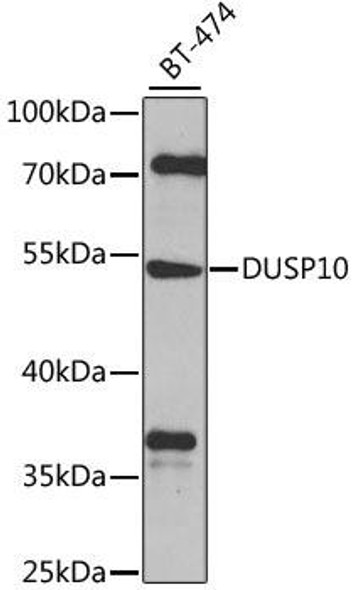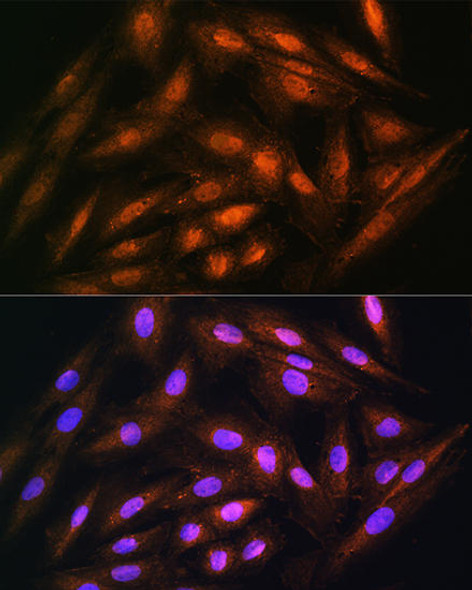Anti-DUSP1 / MKP1 Antibody (CAB2919)
- SKU:
- CAB2919
- Product type:
- Antibody
- Reactivity:
- Human
- Mouse
- Rat
- Host Species:
- Rabbit
- Isotype:
- IgG
- Research Area:
- Cell Cycle
Description
| Antibody Name: | Anti-DUSP1 / MKP1 Antibody |
| Antibody SKU: | CAB2919 |
| Antibody Size: | 20uL, 50uL, 100uL |
| Application: | WB IF |
| Reactivity: | Human, Mouse, Rat |
| Host Species: | Rabbit |
| Immunogen: | A synthetic peptide of human DUSP1 / MKP1 |
| Application: | WB IF |
| Recommended Dilution: | WB 1:500 - 1:2000 IF 1:50 - 1:200 |
| Reactivity: | Human, Mouse, Rat |
| Positive Samples: | HepG2, BT-474, Mouse brain |
| Immunogen: | A synthetic peptide of human DUSP1 / MKP1 |
| Purification Method: | Affinity purification |
| Storage Buffer: | Store at -20°C. Avoid freeze / thaw cycles. Buffer: PBS with 0.02% sodium azide, 50% glycerol, pH7.3. |
| Isotype: | IgG |
| Sequence: | Email for sequence |
| Gene ID: | 1843 |
| Uniprot: | P28562 |
| Cellular Location: | Nucleus |
| Calculated MW: | 39kDa |
| Observed MW: | 49kDa |
| Synonyms: | DUSP1, CL100, HVH1, MKP-1, MKP1, PTPN10 |
| Background: | The expression of DUSP1 gene is induced in human skin fibroblasts by oxidative/heat stress and growth factors. It specifies a protein with structural features similar to members of the non-receptor-type protein-tyrosine phosphatase family, and which has significant amino-acid sequence similarity to a Tyr/Ser-protein phosphatase encoded by the late gene H1 of vaccinia virus. The bacterially expressed and purified DUSP1 protein has intrinsic phosphatase activity, and specifically inactivates mitogen-activated protein (MAP) kinase in vitro by the concomitant dephosphorylation of both its phosphothreonine and phosphotyrosine residues. Furthermore, it suppresses the activation of MAP kinase by oncogenic ras in extracts of Xenopus oocytes. Thus, DUSP1 may play an important role in the human cellular response to environmental stress as well as in the negative regulation of cellular proliferation. |
| UniProt Protein Function: | MKP-1: a non-receptor, dual-specificity phosphoprotein phosphatase (DUSP). Different members of the DUSP family show distinct substrate specificities for MAPKs, different tissue distribution and subcellular localization, and different modes of inducibility of their expression by extracellular stimuli. DUSP1 specifically inactivates mitogen-activated protein (MAP) kinase in vitro by the concomitant dephosphorylation. It is induced in human skin fibroblasts by oxidative/heat stress and growth factors. Contains 1 rhodanese domain. |
| UniProt Protein Details: | Protein type:Protein phosphatase, dual-specificity; EC 3.1.3.48; Motility/polarity/chemotaxis; EC 3.1.3.16 Chromosomal Location of Human Ortholog: 5q34 Cellular Component: cytoplasm; nucleus Molecular Function:protein tyrosine/threonine phosphatase activity; protein binding; non-membrane spanning protein tyrosine phosphatase activity; protein tyrosine/serine/threonine phosphatase activity; MAP kinase tyrosine/serine/threonine phosphatase activity Biological Process: negative regulation of MAP kinase activity; response to light stimulus; response to retinoic acid; response to cAMP; negative regulation of MAPKKK cascade; positive regulation of apoptosis; response to glucocorticoid stimulus; negative regulation of meiotic cell cycle; response to testosterone stimulus; protein amino acid dephosphorylation; response to estradiol stimulus; cellular response to hormone stimulus; regulation of apoptosis; response to hydrogen peroxide; endoderm formation; response to oxidative stress; response to calcium ion; negative regulation of apoptosis; inactivation of MAPK activity |
| NCBI Summary: | The expression of DUSP1 gene is induced in human skin fibroblasts by oxidative/heat stress and growth factors. It specifies a protein with structural features similar to members of the non-receptor-type protein-tyrosine phosphatase family, and which has significant amino-acid sequence similarity to a Tyr/Ser-protein phosphatase encoded by the late gene H1 of vaccinia virus. The bacterially expressed and purified DUSP1 protein has intrinsic phosphatase activity, and specifically inactivates mitogen-activated protein (MAP) kinase in vitro by the concomitant dephosphorylation of both its phosphothreonine and phosphotyrosine residues. Furthermore, it suppresses the activation of MAP kinase by oncogenic ras in extracts of Xenopus oocytes. Thus, DUSP1 may play an important role in the human cellular response to environmental stress as well as in the negative regulation of cellular proliferation. [provided by RefSeq, Jul 2008] |
| UniProt Code: | P28562 |
| NCBI GenInfo Identifier: | 1346900 |
| NCBI Gene ID: | 1843 |
| NCBI Accession: | P28562.3 |
| UniProt Secondary Accession: | P28562,Q2V508, D3DQL9, |
| UniProt Related Accession: | P28562 |
| Molecular Weight: | 367 |
| NCBI Full Name: | Dual specificity protein phosphatase 1 |
| NCBI Synonym Full Names: | dual specificity phosphatase 1 |
| NCBI Official Symbol: | DUSP1 |
| NCBI Official Synonym Symbols: | HVH1; MKP1; CL100; MKP-1; PTPN10 |
| NCBI Protein Information: | dual specificity protein phosphatase 1; MAP kinase phosphatase 1; protein-tyrosine phosphatase CL100; dual specificity protein phosphatase hVH1; serine/threonine specific protein phosphatase; mitogen-activated protein kinase phosphatase 1 |
| UniProt Protein Name: | Dual specificity protein phosphatase 1 |
| UniProt Synonym Protein Names: | Dual specificity protein phosphatase hVH1; Mitogen-activated protein kinase phosphatase 1; MAP kinase phosphatase 1; MKP-1; Protein-tyrosine phosphatase CL100 |
| Protein Family: | Dual specificity protein phosphatase |
| UniProt Gene Name: | DUSP1 |
| UniProt Entry Name: | DUS1_HUMAN |







